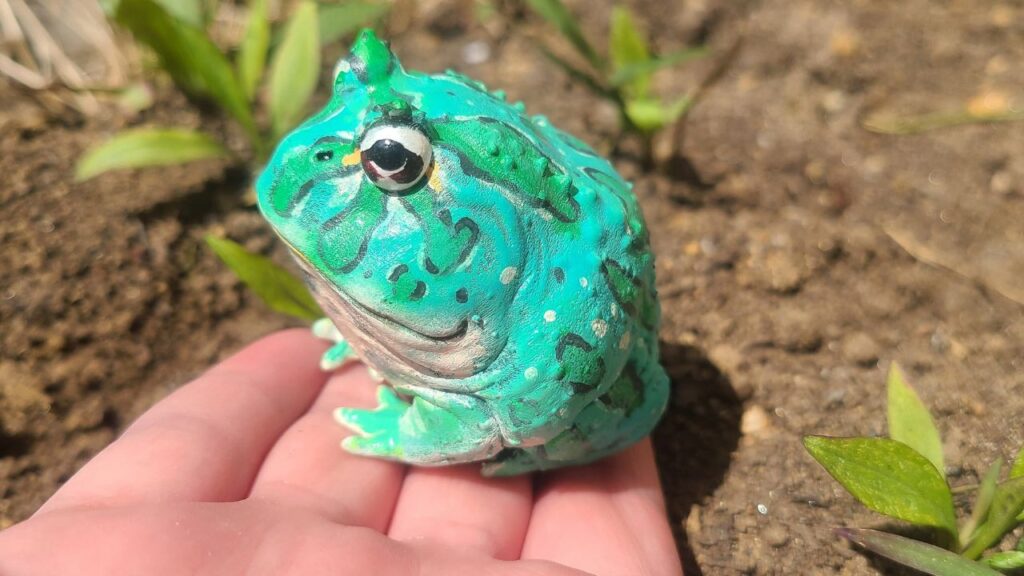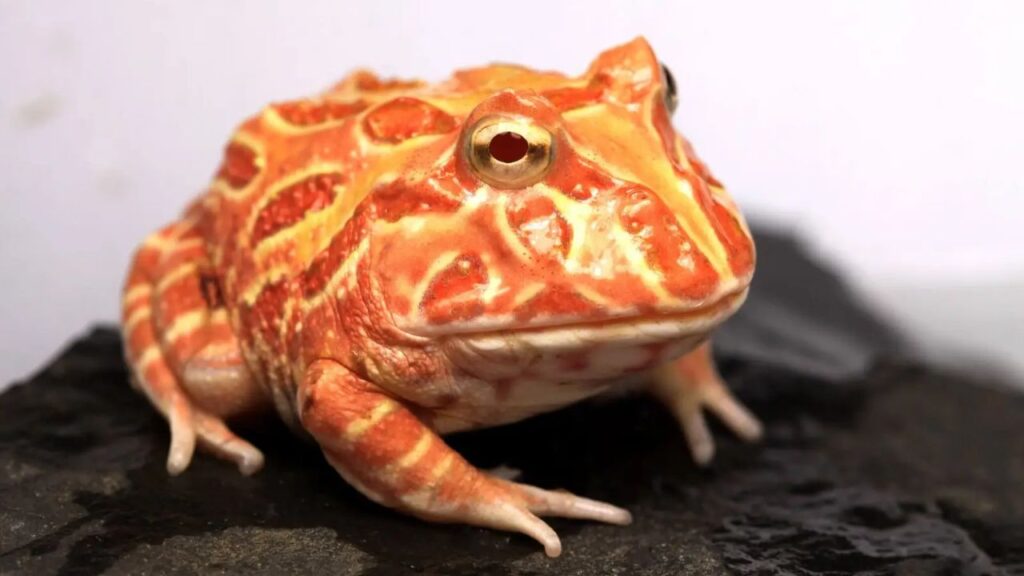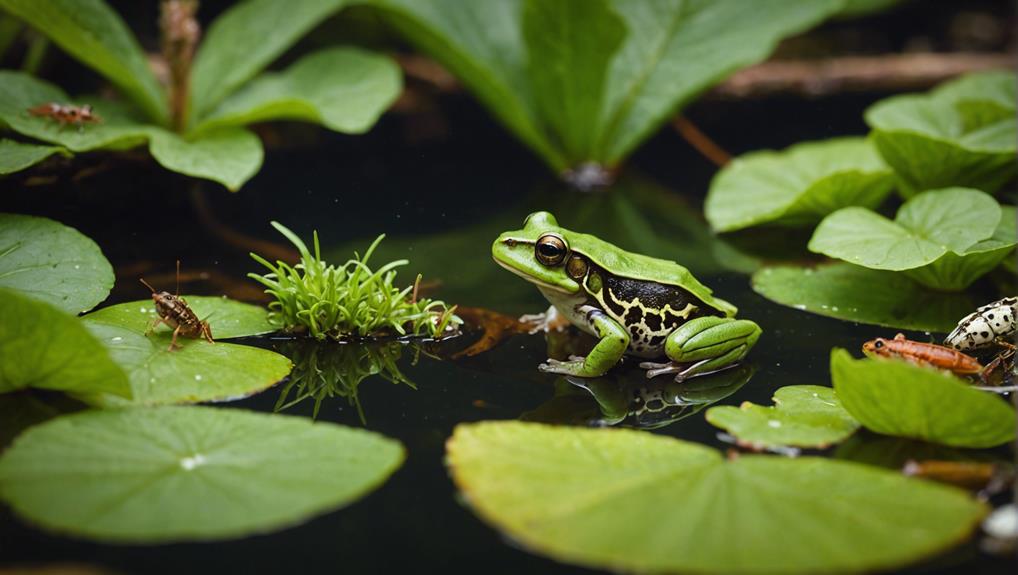You’re about to bring a blue Pacman frog into your life, and with the right care and attention, it can thrive and become a beloved pet. To get started, select a well-ventilated, secure enclosure that’s at least 5-10 gallons in size.
Feed your frog a mix of crickets, mealworms, and waxworms 2-3 times a week, and supplement with calcium and vitamin D3 powder. Maintain a humidity level between 50% and 70% and a temperature between 75°F and 85°F. Regularly inspect your frog’s skin, eyes, and behavior to detect potential health issues early on.
There’s more to learn to support a happy, healthy frog – stay tuned to discover the rest of the essentials.
Housing Your Blue Pacman Frog
When bringing a blue Pacman frog into your life, you must create a comfortable and safe habitat that mirrors its natural environment.
Start by selecting a well-ventilated, secure enclosure that’s at least 5-10 gallons in size. This will give your frog ample space to move around and thrive. You’ll also want to verify the enclosure is escape-proof, as blue Pacman frogs are skilled jumpers and can squeeze through tiny openings.
Next, consider the substrate, or flooring, of the enclosure.
A mix of sphagnum moss, coconut fiber, and perlite works well, retaining humidity and being easy to clean. Avoid gravel, sand, or wood shavings, as they can cause respiratory issues or intestinal blockages if ingested.
Temperature and humidity levels are also vital.
Blue Pacman frogs thrive in a warm, humid environment, with a temperature range of 75-85°F (24-29°C) and a relative humidity of 50-70%. You can achieve this by using a heat source, such as a heat lamp or ceramic heat emitter, and misting the enclosure with water daily.
Diet and Nutrition Needs
A well-fed frog is a happy and healthy frog, so getting this right is vital. Aim to feed your frog 2-3 times a week, depending on its age and size. You can offer a mix of crickets, mealworms, and waxworms, but make sure to gut-load them with nutrient-rich foods first. You can also supplement with calcium and vitamin D3 powder to guarantee your frog is getting all the nutrients it needs.
It’s vital to vary the size and type of insects to cater to your frog’s different life stages. For example, hatchlings and juveniles require smaller prey like fruit flies or pinhead crickets, while adults can handle larger insects like super worms or roaches. Be sure to research the specific dietary needs of your frog’s life stage to confirm you’re providing the best possible nutrition.
Remember to remove any uneaten insects after a few hours to maintain a clean and hygienic environment. You’ll also need to provide a shallow water dish for your frog to soak in and drink from.
Humidity and Temperature Control
Creating an environment with the right humidity and temperature levels is essential to your blue Pacman frog‘s overall health, as these factors can profoundly impact its metabolism, skin health, and overall well-being.
You’ll want to aim for a humidity level between 50% to 70%, which you can achieve by misting the enclosure with water daily. You can also use a hygrometer to monitor the humidity levels.
As for temperature, blue Pacman frogs thrive in a range of 75°F to 85°F (24°C to 29°C), with a slight drop in temperature at night. You can use a heat source, such as a heat lamp or ceramic heat emitters, to maintain the desired temperature.
However, be cautious not to overheat the enclosure, as this can be detrimental to your frog’s health.
It’s vital to monitor the temperature and humidity levels regularly to guarantee your frog’s environment remains stable. You can do this by using thermometers and hygrometers, which will give you an accurate reading of the conditions.
Health Checks and Hygiene
Regularly inspecting your blue Pacman frog‘s skin, eyes, and overall behavior helps detect potential health issues before they become severe.
You can do this by observing your frog’s appearance and behavior daily. Check for any changes in skin color, texture, or lesions. Make sure its eyes are clear and free of discharge. Observe how it moves, eats, and breathes. Any changes could indicate an underlying issue.
Maintaining good hygiene is essential in preventing the spread of diseases and parasites.
Clean your frog’s enclosure regularly by removing feces and uneaten food daily. Change the substrate completely every week or two. Disinfect all accessories, such as food and water dishes, with a reptile-safe cleaning solution. Wash your hands thoroughly before and after handling your frog or its enclosure.
Quarantine any new frogs or animals before introducing them to your blue Pacman frog to prevent the transmission of diseases.
Keep a close eye on your frog’s weight, as sudden changes can indicate illness. Monitor its appetite and stool quality as well. By being proactive and vigilant, you can detect potential health issues early on and provide your blue Pacman frog with the best possible care.
Handling and Socialization Tips
By gently scooping up your blue Pacman frog with a cupped hand, you can help it become comfortable with handling and develop trust.
Start with short sessions, about 5-10 minutes, to avoid stressing your frog. As you hold your frog, speak softly and move slowly to avoid startling it. Be patient, as building trust takes time.
When handling your blue Pacman frog, supporting its body and legs is vital.
Hold your frog securely but gently, making sure not to constrict its movement. You can also place your frog on your hand or arm, allowing it to explore and get accustomed to your presence.
Socialization is vital for your frog’s well-being.
Handle your frog regularly to help it become calm and relaxed in your presence. As your frog becomes more comfortable, you can increase handling time. Remember to wash your hands before and after handling your frog to prevent the transfer of bacteria.
Tips for handling your blue Pacman frog:
- Handle your frog in a quiet, calm environment to minimize stress.
- Avoid handling your frog when it’s shedding or molting, as this can cause stress.
- Supporting your frog’s body and legs when handling is vital to prevent injury.
- Be patient and gentle when handling your frog to build trust.
Frequently Asked Questions
Can I Keep My Blue Pacman Frog in an Aquarium With Fish?
You’re wondering if you can keep your blue Pacman frog with fish in an aquarium. Unfortunately, it’s not recommended, as frogs have different water requirements and may eat small fish or be stressed by their presence.
How Often Should I Clean the Frog’s Water Bowl?
Coincidentally, you’re wondering how often to clean your frog’s water bowl, just like you wash your hands daily! Clean the bowl every 2-3 days to prevent bacterial growth, and refresh the water completely every week.
Can I Use a Heat Rock to Warm My Frog’s Habitat?
You shouldn’t use a heat rock to warm your frog’s habitat as they can cause burns and create hotspots, opt for a heat source specifically designed for reptiles or amphibians, like a heat mat or ceramic heat emitters.
Will My Blue Pacman Frog Recognize Its Name if I Call It?
You wonder if your frog will recognize its name when you call it. Honestly, frogs don’t possess the cognitive ability to associate sounds with meanings, so they won’t respond to its name like a dog would.
Can I Take My Blue Pacman Frog for a Walk Outside?
“As you step outside, imagine freedom’s leash in your hand, but don’t let your heart get tangled. Unfortunately, your blue friend isn’t suited for walks; their sensitive skin and delicate respiratory system can’t handle outdoor stress.”


